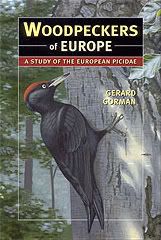 Woodpeckers have extensible tongues. In some species they are even prehensile. There are two basic types of woodpecker tongue: those with pointed tips and those with blunt, rounded tips. Pointed tongues are used to impale prey, rounded tongues are covered in a sticky substance and are used to lap up prey. We might say the first feeding method uses a spear, the second a gluey lasso. Tongues are also barbed but this varies between species. As a rule the more arboreal species (such as the Dendrocopos species) have more barbs on their tongues than the more terrestrial species (Picus species). Tongue length varies between species, too, and is also related to feeding methods. Species that specialise in eating ants tend to have longer tongues than those that feed on wood-dwelling beetles. In Europe the two Picus species, Green and Grey-headed (Grey-faced) Woodpeckers have the longest tongues. These long tongues are retracted and stored (in a loop) in a cavity around the skull and fixed near the nostril or eye-socket. This fantastic photo of a Great Spotted Woodpecker, with tongue protruding, was taken in Hungary by Laszlo Nehezy.
Woodpeckers have extensible tongues. In some species they are even prehensile. There are two basic types of woodpecker tongue: those with pointed tips and those with blunt, rounded tips. Pointed tongues are used to impale prey, rounded tongues are covered in a sticky substance and are used to lap up prey. We might say the first feeding method uses a spear, the second a gluey lasso. Tongues are also barbed but this varies between species. As a rule the more arboreal species (such as the Dendrocopos species) have more barbs on their tongues than the more terrestrial species (Picus species). Tongue length varies between species, too, and is also related to feeding methods. Species that specialise in eating ants tend to have longer tongues than those that feed on wood-dwelling beetles. In Europe the two Picus species, Green and Grey-headed (Grey-faced) Woodpeckers have the longest tongues. These long tongues are retracted and stored (in a loop) in a cavity around the skull and fixed near the nostril or eye-socket. This fantastic photo of a Great Spotted Woodpecker, with tongue protruding, was taken in Hungary by Laszlo Nehezy.
Wednesday, 20 February 2008
Tongues
 Woodpeckers have extensible tongues. In some species they are even prehensile. There are two basic types of woodpecker tongue: those with pointed tips and those with blunt, rounded tips. Pointed tongues are used to impale prey, rounded tongues are covered in a sticky substance and are used to lap up prey. We might say the first feeding method uses a spear, the second a gluey lasso. Tongues are also barbed but this varies between species. As a rule the more arboreal species (such as the Dendrocopos species) have more barbs on their tongues than the more terrestrial species (Picus species). Tongue length varies between species, too, and is also related to feeding methods. Species that specialise in eating ants tend to have longer tongues than those that feed on wood-dwelling beetles. In Europe the two Picus species, Green and Grey-headed (Grey-faced) Woodpeckers have the longest tongues. These long tongues are retracted and stored (in a loop) in a cavity around the skull and fixed near the nostril or eye-socket. This fantastic photo of a Great Spotted Woodpecker, with tongue protruding, was taken in Hungary by Laszlo Nehezy.
Woodpeckers have extensible tongues. In some species they are even prehensile. There are two basic types of woodpecker tongue: those with pointed tips and those with blunt, rounded tips. Pointed tongues are used to impale prey, rounded tongues are covered in a sticky substance and are used to lap up prey. We might say the first feeding method uses a spear, the second a gluey lasso. Tongues are also barbed but this varies between species. As a rule the more arboreal species (such as the Dendrocopos species) have more barbs on their tongues than the more terrestrial species (Picus species). Tongue length varies between species, too, and is also related to feeding methods. Species that specialise in eating ants tend to have longer tongues than those that feed on wood-dwelling beetles. In Europe the two Picus species, Green and Grey-headed (Grey-faced) Woodpeckers have the longest tongues. These long tongues are retracted and stored (in a loop) in a cavity around the skull and fixed near the nostril or eye-socket. This fantastic photo of a Great Spotted Woodpecker, with tongue protruding, was taken in Hungary by Laszlo Nehezy.
Subscribe to:
Post Comments (Atom)





2 comments:
Amazing..Two months ago, I saw hummingbird toungues now, you've shown me woodpecker tongues. Do you shoot from a blind ? I stalk birds for shots , but I can't get near enough to get these kind of pictures. I guess I need an optical enhancement for my camera.
I will check back later..have bookmarked your site, Thanks for the pictures...joe b
miiannaai833jk
golden goose outlet
golden goose outlet
golden goose outlet
golden goose outlet
golden goose outlet
golden goose outlet
golden goose outlet
supreme outlet
supreme outlet
golden goose outlet
Post a Comment